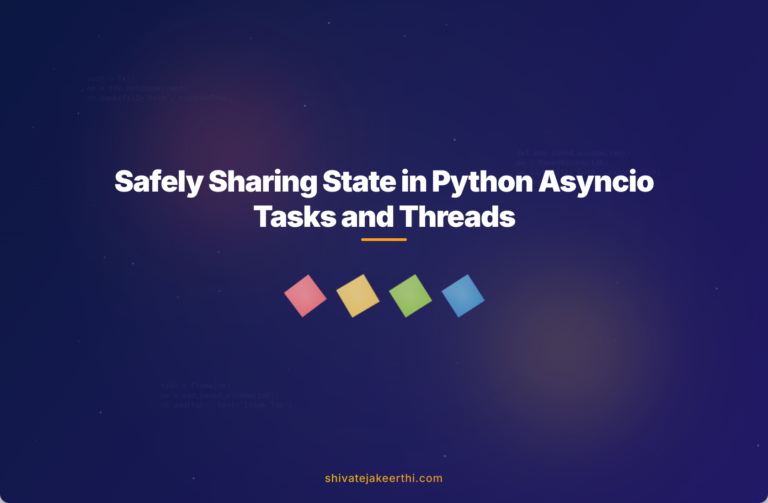When working with Python, combining asyncio and traditional threads seems like a perfect approach to improve concurrency. But handling shared mutable state between these two parallel programming models can quickly become tricky.
Imagine this scenario: you’re building a Python application that fetches data asynchronously over the network while also running CPU-intensive tasks in background threads. Both of these components need to update a shared cache frequently. Suddenly, you start noticing strange outputs, inconsistent states, or even crashes. What’s going on?
How Asyncio and Threading Differ in Python
To understand this problem clearly, let’s first briefly recap how these two concurrency models differ.
Asyncio is an asynchronous programming library built into Python that lets you write concurrent code using the async/await syntax. It primarily focuses on managing I/O-bound tasks—like database queries, API calls, or reading files—efficiently and without blocking the main thread. Under the hood, asyncio runs a single-threaded event loop responsible for managing and executing asynchronous tasks.
On the other hand, Threading involves traditional multi-threading (running multiple threads simultaneously within the same process). While threads are genuinely useful for parallelizing CPU-intensive tasks and working around blocking libraries, they’re managed differently by Python’s threading infrastructure and the Global Interpreter Lock (GIL).
Common Challenges When Sharing State Between Asyncio Tasks and Threads
Combining asyncio tasks (managed by an event loop) with synchronous threads introduces complexity. When multiple threads or asynchronous tasks access and modify mutable state simultaneously without proper synchronization, you risk encountering two major problems:
- Race Conditions: These happen when the output of your program depends on the timing and order in which threads and tasks access shared resources.
- Deadlocks and Locks: Improper lock management could cause your application to freeze completely when two threads block each other indefinitely.
To illustrate, consider you have a global dictionary acting as your cache. If an asyncio task and a separate thread both modify the dictionary simultaneously, there could be an unpredictable and inconsistent state—not good news for your application’s reliability or data integrity.
The Standard Approach and Its Limitations
Initially, developers might reach for traditional threading synchronization tools like threading.Lock:
import threading
lock = threading.Lock()
def thread_task(shared_dict, key, value):
with lock:
shared_dict[key] = value
This strategy works fine when used purely in synchronous contexts. But when mixing thread locks with asyncio code, you could accidentally block your event loop, unintentionally freezing your entire application. Why?
Asyncio tasks run in a single-threaded event loop. If you use a synchronous lock (like threading.Lock) inside an async function, it could halt the event loop, blocking all other asyncio tasks until the lock is released, seriously impairing performance and responsiveness.
Best Practices for Sharing State Between Asyncio and Threads
A safer approach involves clearly defining boundaries. Here’s a golden rule worth repeating:
- Confine any state mutations strictly to the asyncio event loop
- Use asyncio-specific synchronization mechanisms rather than traditional thread-locking approaches
- Use the producer/consumer pattern with safer constructs like queues or message passing for cross-communication
This helps ensure that only a single mechanism is responsible for modifying shared state, drastically reducing complexity and potential for mistakes.
Effective Design Patterns to Solve the Synchronization Problem
A common solution for safely sharing state between threads and asyncio applications is using queues or message passing. For example, your threads could send data into an event loop using an asyncio.Queue. The event loop then exclusively performs state modification using this queued data:
import asyncio
from threading import Thread
async def manage_cache(cache, queue):
while True:
key, value = await queue.get()
cache[key] = value
queue.task_done()
def thread_worker(queue):
# a synchronous thread puts data into async queue
for i in range(5):
asyncio.run_coroutine_threadsafe(queue.put((f"key-{i}", f"value-{i}")), loop)
cache = {}
queue = asyncio.Queue()
loop = asyncio.get_event_loop()
# Start background task in event loop
loop.create_task(manage_cache(cache, queue))
# Start threads that will put data into the queue
threads = [Thread(target=thread_worker, args=(queue,)) for _ in range(2)]
for t in threads:
t.start()
loop.run_until_complete(queue.join())
This design neatly solves handling shared state—by delegating all mutable state updates to the asyncio event loop. Threads don’t modify the cache directly: they pass messages asynchronously instead, ensuring safe interactions without the need for explicit locking.
Implementing a Robust Solution in Real-World Applications
Here’s a complete and robust example demonstrating best practices clearly in action:
import asyncio
import concurrent.futures
shared_states = {}
async def update_state_from_queue(queue):
while True:
key, value = await queue.get()
shared_states[key] = value
queue.task_done()
def cpu_intensive_task(data):
# simulate heavy computation
import time
time.sleep(2)
return data.upper()
async def main():
loop = asyncio.get_event_loop()
queue = asyncio.Queue()
# Start queue listener
asyncio.create_task(update_state_from_queue(queue))
# Run synchronous tasks in separate threads using ThreadPoolExecutor
with concurrent.futures.ThreadPoolExecutor() as executor:
tasks = []
data_to_process = ['alpha', 'beta', 'gamma', 'delta']
for item in data_to_process:
# Run synchronous functions safely in background threads
future = loop.run_in_executor(executor, cpu_intensive_task, item)
# Once result is ready, put it on the asyncio queue
future.add_done_callback(
lambda fut, key=item: asyncio.run_coroutine_threadsafe(queue.put((key, fut.result())), loop)
)
tasks.append(future)
# await completion of all CPU-intensive tasks
await asyncio.gather(*tasks)
await queue.join()
print(shared_states)
asyncio.run(main())
This practical example illustrates how to combine asyncio tasks, threads, and shared mutable state safely. It ensures:
- No direct thread interaction with shared mutable state.
- Reliable coordination through message passing.
- Avoidance of race conditions or deadlocks.
You gain clarity, flexibility, and robustness—ideal traits when scaling your concurrent Python applications.
Sharing state between asynchronous tasks and threads doesn’t need to be daunting if you stick to safe patterns like message passing and separation of concerns. Remember: threads handle CPU-intensive synchronous tasks, your asyncio event loop manages I/O and shared state, and communication happens through clearly defined queues or messaging mechanisms.
Carefully following good design principles makes your concurrent Python applications both efficient and less error-prone. How do you handle shared state in your projects? Have any tips or experiences you’d like to share? Drop a comment below or explore more Python programming tips on our Python category page.



0 Comments